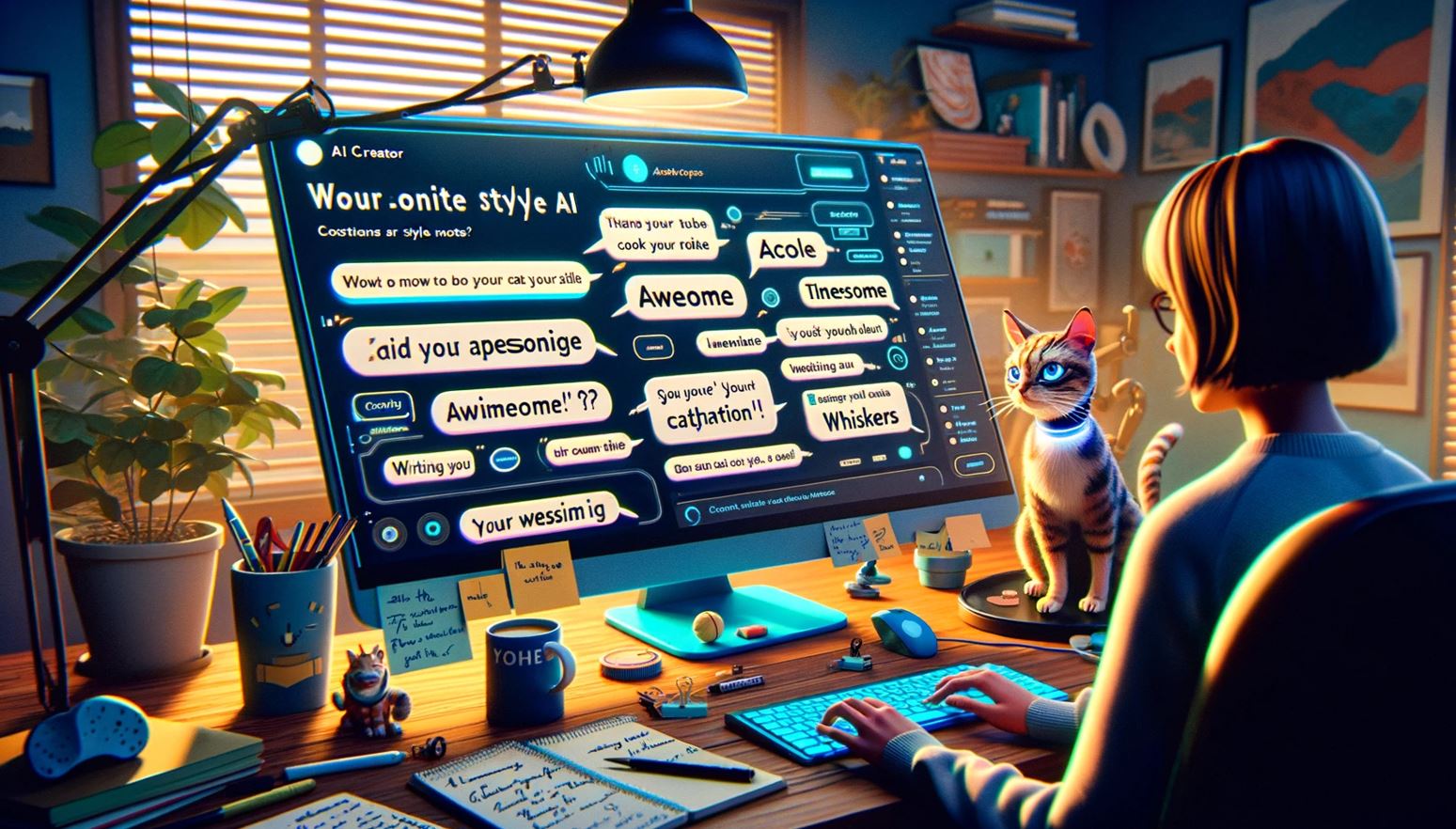Ever felt like the content your AI writer wrote was too robotic? Then maybe it’s time you learn how to humanize AI-generated text.
It’s a common struggle in our tech-driven world where AI-generated text is becoming more and more prevalent. But what if I told you there’s a way to warm it up, add some life — to humanize it?

Try these new AI-powered tools:
- 5 Best AI Detectors To Unmask AI-Written Content With Accuracy
- 5 Best AI Writers To Boost Your Productivity And Content Quality.
- This "Secret AI Writer" Can Bypass AI Detection Like A Pro.
Here’s the scoop: personal tales and emotional color can transform your AI-crafted words from monotonous to memorable. Think of it as adding a dash of your favorite seasoning to an otherwise bland meal.
My upcoming tips will be your recipe for infusing personality into those lines of code-generated content, making them resonate with real human vibes.
So, are you all set to learn how to humanize AI-generated Text? Let’s begin.
Article At-A-Glance
- Share your own stories and experiences to make AI text warm and personal.
- Use emotional words to connect with readers and make them feel something.
- Be specific when you give instructions to AI, so it writes in a way that’s true to you.
- Double-check AI work for mistakes or facts that are not right.
- Edit the AI writing to add your unique voice and style.
Table Of Contents
Tips On How To Humanize AI-Generated Text
Ever feel like your AI-generated content has the warmth of a robot handshake? We’re about to infuse some much-needed personality into those chilly lines of text.
Let’s dive into the secret sauce for keeping it real – because your readers can totally spot a digital imposter, and we want them nodding along to your beat, not scratching their heads at clunky, algorithmic prose.
Adding Personal Experiences And Anecdotes
Have you ever read something and thought, “Wow, this feels like a chat with an old friend?” That’s the magic of personal stories. They turn plain words into cozy talks. Sharing tales from your life does wonders for AI text—it makes it warm and welcoming.
Like that time I tried to bake cookies and ended up with a kitchen full of smoke! You start seeing the person behind the screen, not just cold computer talk.
Let’s sprinkle our writing with bits of ‘us’. It might be how your grandma’s advice helped you at work or how you felt when you saw the ocean for the first time—moments that light up eyes and hearts.
This way, we invite readers into our world. It’s no longer just reading—it’s connecting. Believe me, everyone loves a good story—especially one they can see themselves in. And suddenly, what seemed like techy robot-speak now has laughter, sighs, nods—a heartbeat.
Using Emotional Language
So, you’ve sprinkled in your own stories. Great! Next up—let’s talk heart. Yep, embracing those feels makes your writing sing. Ever read something that made you laugh or tear up? That’s emotional language at work—it grabs folks by the heartstrings and pulls ’em right in.
Think about it: when you chat with friends, you don’t just spill facts, right? You share laughs, sighs, maybe even a happy dance or two. So go on—throw in words that make readers feel like they’re right there with you.
Smiles, frowns …. all the feels should jump off the page!
And hey! Emotions are powerful stuff—they turn plain old text into an experience. They put the “human” in humanized content. They’re what connect us after all! Painting pictures with passionate phrases gives your AI-assisted text that unique touch only humans can provide—a voice as authentic as yours is pretty special.
Remember this trick: mix it up with joy, surprise, sadness—whatever fits your tale best—and watch how people lean into every word you say… or well—in this case, every word they read!
Being Specific With Prompts
Give the AI clear instructions, and you’ll get better stuff out of it. Picture yourself telling a friend exactly what you want for your birthday—that’s how specific your prompts should be.
Say things like, “Write a story about a girl who finds a lost puppy in the park,” instead of just “write about pets.” This gets the AI on track to make content that feels more real and less robotic.
Say things like, “Write a story about a girl who finds a lost puppy in the park,” instead of just “write about pets.” This gets the AI on track to make content that feels more real and less robotic.
Let’s say you’re all about adding laughs and tales from your own life into your posts. Train the AI by showing it examples of how you write, or tell it straight up: “Use my laid-back style and crack some jokes.” Mixing this with personal touches helps keep things true to your voice while also bringing in that human warmth we all love in stories and chats with friends.
Training AI To Match Your Style
You can make AI sound more like you! First, think about how you write. Do you tell jokes? Are your sentences short and snappy or long and flowy? Tell the AI to do the same things. This way, it learns your style and starts writing like that too.
It’s almost like showing a friend how to cook your favorite meal – pretty soon, they’ll be able to whip it up just like you do.
Now let’s dive into using specific words and phrases that scream “you.” Maybe you love saying “awesome” or always talk about your cat whiskers. Put those into the AI prompts as well.
This helps keep what makes your brand special—your voice—in everything written with AI. And this isn’t just nice. It’s smart business too because people come back for that unique flavor only you have!
Using AI As A Research Assistant
Think of AI as a smart helper who digs up facts and data for your story. Your writing gets better with cool info that readers love. But here’s the key: mix those AI findings with your own spice—stories only you can tell or stuff you feel in your heart.
Let’s get real, using AI to sort through tons of information saves time, right? Then, take what it gives you and make it shine by adding bits about your life or setting the scene with rich details.
This way, personal touches keep things fresh and smack dab on track for telling a killer tale!
Fact-Checking And Editing
AI can mess up facts. It’s smart, but not perfect. You’ve got to check if what it writes is true. Look at every fact, number, and name the AI drops in your text. Make sure they’re right or you could end up with egg on your face.
Editing gives your content a human touch. Go over what the AI wrote like a detective with a magnifying glass. Change words here and there to sound more like you. Sprinkle in some of that personal spice! Fix any odd parts so people can’t tell a robot helped you out.
Oh—and watch for sneaky biases that might have crept in because we don’t want those!
Understanding The Need For Humanizing AI-Generated Text
Let’s get real for a sec—while AI can spit out words faster than that one friend who talks a mile a minute, it often misses the warmth and fuzzies that make you go “Ah, someone gets me.” That human sparkle? It’s kind of a big deal because let’s face it: nobody wants to feel like they’re chatting with a robot who’s just nodding along.
We’re here to dive into why giving AI writing that unmistakable heartbeat is crucial—because at the end of the day, we all want to read something with soul, not just syntax.

Uniqueness Of Human Writing
Humans have a special way of putting words together. We share our own stories and feelings in what we write. This makes our writing full of life, warmth, and something called personality.
Imagine reading a letter from a friend—it’s as if they are right there with you! They might make you laugh or feel comforted just with their words.
AI, though super smart, doesn’t quite get this yet. It can miss the little things that show care or excitement. People want to read stuff that feels real and true to them—like someone really gets them.
That’s where humans shine in their writing—we know how to hit the heart just right!
Detached And Bland Nature Of AI Content
AI has a hard time with complex feelings and cultural hints. This makes its writing seem cold and robotic like there’s no real person behind the words. It can churn out text fast, sure, but this machine-generated stuff often misses the mark on being warm or interesting.
Think of it as a chef who knows how to cook but can’t taste—the food comes out okay, but it lacks that special flavor.
That’s why when you read AI content, it might not stick with you. It feels impersonal—like getting a smile from someone wearing sunglasses. You just don’t get the full picture. Now let’s talk about how to catch those flaws early with AI checker tools.
Utilizing AI DetectionTools
So you’ve got a bunch of text and want to make sure it doesn’t sound like a robot wrote it, right? This is where AI checker tools come in real handy. These smart programs look at your words and tell you if they seem too much like they’re from an AI.
They check how the language flows and spot any clues that might not feel quite human.
Now, these tools do more than just point out the robotic parts. They can catch when facts aren’t right or when some bias creeps into your writing without you even noticing. Think about it: You get to keep all the cool stuff AI helps with, like coming up with ideas or summing things up, but then you use these tools to add that personal touch.
Imagine having a high-tech buddy who tells you what needs spicing up! Plus, they’re super helpful for school work or articles – making sure everything sounds authentic and keeps your unique voice shining through.
Enhancing Content Quality With Humanized AI Text
Making AI text feel more human can really grab a reader’s attention. It sounds less robotic and more like a friend talking to you. Picture this – you’re reading something that knows just what to say, how you feel, and even gives off good vibes!
To do this well, sprinkle in real-life stories or throw in some cool words that make the heart sing. Sure, AI is smart, but it doesn’t know everything about being human – yet.
That’s where Humanize AI Text comes in! This particular software tweaks the words here and there, double-check facts and polish it until it shines like new.
That’s where Humanize AI Text comes in! This particular software tweaks the words here and there, double-check facts and polish it until it shines like new.
In the end? It’s content touched by humans for humans – genuine, engaging, and oh-so-readable!
How To Get The Most Out Of AI Content
AI content needs a human touch to feel real. Here’s how you can make AI work harder for you:
- Mix in your own stories and funny moments. It’s as if you’re adding spices to a dish. It brings out the flavor.
- Throw in feelings and passion. Words that show excitement or sadness grab attention.
- Check facts twice. Make sure what AI tells you is true before sharing it.
- Keep your purpose clear. Ask yourself, “Is this text doing what I want it to?”
- Pick the right tools for the job. Some programs help add that human sparkle to AI words.
- Edit with your voice in mind. Change things up until it sounds just like you.
- Say hello to AI humanizer gadgets. They’re like friendly robots that help your text sound superhuman.
Infuse Your Voice With Emotions To Humanize AI-Generated Text
So, you want to make your AI text sound more like a real person wrote it? Well, mix in some of your own stories. That’s a good start. Don’t forget to sprinkle in feelings and words that show emotion.
People relate to that.
Always check your facts! And hey, why not use those cool AI tools online? They can be a big help.
Think about how you write and teach the AI to do the same. It’ll keep things sounding just like you.
Remember, keeping it real with personal touches makes everyone want to read what you’ve got. So, go ahead—give these tips a try and see how they bring life to your words!
FAQs
1. What’s the first step to make AI text sound more human?
Start by throwing in some casual words and phrases, kind of like how you’d chat with a friend.
2. Can asking questions in AI text help it seem more real?
Absolutely, peppering in questions is like tossing a ball back to the reader – keeps things lively!
3. Should I put jokes in AI-generated text?
Sure thing! A good laugh breaks the ice and makes any robot text seem way chummier.
4. Is it okay for AI text to go off on a tangent sometimes?
Yep, going off-track now and then adds a nice, personal touch – just don’t lose your way!
5. How do I know if my AI text feels too stiff or formal?
If it sounds like something out of an old textbook, loosen up with some easy-going words and watch it transform!
Meet our resident tech wizard, Steve the AI Guy. Now, before you get any wild ideas, let’s clear up one thing – he’s 100% human! I mean, he’s got the work history to prove it. He spent a decade diving into the deep end of the tech industry doing business intelligence work, splashing around with two of the world’s largest business consulting companies, Deloitte and Ernst & Young. Learn More










